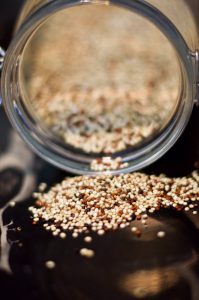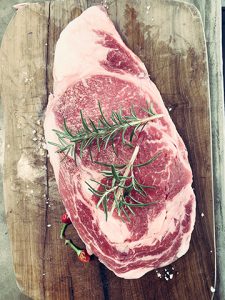Eat Right And Keep Your Tummy Tight
 At Rising Fitness in Houston, Texas, everyone works hard to get the results they want. One of the most frequent goals we often hear is the desire for a tight tummy. That takes more than just exercise. You have to eat right, too. In order to lose belly fat, you have to lose fat all over your body. Belly fat is visceral fat, the most dangerous type of fat, since it crowds your organs and increases the risk of diabetes, cardiovascular disease, some types of cancer and hypertension. You need to exercise to strengthen abdominal muscles, but if there’s a layer of fat, no matter how much of a six pack you have, it won’t show. Eating right solves that problem.
At Rising Fitness in Houston, Texas, everyone works hard to get the results they want. One of the most frequent goals we often hear is the desire for a tight tummy. That takes more than just exercise. You have to eat right, too. In order to lose belly fat, you have to lose fat all over your body. Belly fat is visceral fat, the most dangerous type of fat, since it crowds your organs and increases the risk of diabetes, cardiovascular disease, some types of cancer and hypertension. You need to exercise to strengthen abdominal muscles, but if there’s a layer of fat, no matter how much of a six pack you have, it won’t show. Eating right solves that problem.
Foods high in fiber are better for eliminating belly fat than others are.
Foods high in fiber are important to making that Buddha belly disappear. There are two types of fiber and both are important. Insoluble fiber can’t be digested by the body, but it does add bulk to the stool to help prevent constipation and the bloating that comes with it. No bloating means a smaller belly. The other type of fiber is soluble. It creates a gel in the intestines that feeds the microbes in the gut and nurtures a wider variety of beneficial gut microbes to aid in digestion. The beneficial microbes also produce short-chain fatty acids, which are linked to reducing or eliminating belly fat. Oatmeal, beans, asparagus, apples, quinoa and avocados are a few of these.
Grab a banana for a snack or put it on your cereal in the morning.
Rather than heading for the candy counter at the grocery or hitting up the candy machine at work, take a banana to work for your afternoon snack. They have the perfect carrying case and are easy to transport. They have resistant starch that triggers the liver to switch burning more fat and gives your metabolism a jump-start in the process. The potassium in the banana help prevent water retention and bloating, too.
Make a non-alcoholic tropical drink.
Toss chunks of pineapple and papaya with coconut milk in a blender for a belly busting drink. The papaya contains papain that breaks down food that’s hard to digest and reduces inflammation and belly bloat. Pineapple is a source of bromelain that also minimizes bloating. Mix it with coconut milk for the MCTs—medium chain triglycerides— that is available immediately for energy and not as likely to be stored as fat. You could also skip the coconut milk and enjoy the papaya or pineapple as a tasty treat.
- Fennel bulb and fennel seed are both good for your digestion and help reduce the bloating that can cause a puffy belly. Make some fennel tea or chew on some fennel seed. Grow fennel in your yard, it has beautiful foliage that is light and delicate.
- No matter what you eat, if you don’t deal with stress, you could potentially accumulate belly fat. Stress increases cortisol levels and cortisol is connected to belly fat. Exercise burns off cortisol and meditation or controlled breathing can help prevent it.
- Apple cider vinegar might help get rid of belly fat. The acetic acid in the vinegar has been shown in animal studies to reduce belly fat and human studies confirm it helps weight loss. A tablespoon in an 8-oz glass of water in the morning is all it takes.
- Sometimes not eating certain foods can bring the biggest benefits. Cut out products with added sugar, white flour, highly processed foods, soft drinks and fried foods to help reduce belly fat.
For more information, contact us today at Rising Fitness Gym



 What is quinoa and why is it so popular? Quinoa is an ancient grain that the world has recently rediscovered. There are many health benefits of quinoa and it’s been used for centuries as food. It is a member of the Chenopodiaceae family that includes spinach, beetroot and sugar beet. Unlike those members, not only can the leaves be harvested and cooked like spinach, the mature seeds were gathered and washed to remove saponins, then cooked and eaten. The saponins removed were used to wash clothing, since they have cleansing properties. No wonder it was called the Mother Grain by the Incas.
What is quinoa and why is it so popular? Quinoa is an ancient grain that the world has recently rediscovered. There are many health benefits of quinoa and it’s been used for centuries as food. It is a member of the Chenopodiaceae family that includes spinach, beetroot and sugar beet. Unlike those members, not only can the leaves be harvested and cooked like spinach, the mature seeds were gathered and washed to remove saponins, then cooked and eaten. The saponins removed were used to wash clothing, since they have cleansing properties. No wonder it was called the Mother Grain by the Incas.
 Do you wish you had a great body, had all the energy you wanted and enjoyed the endurance you had when you were young. You can achieve that, but you have to work for it. It takes more than just making a New Year’s resolution, you have to follow through with action. You can choose to make one change at a time or try to change everything at once. Each person is different, to you have to do what’s best for you.
Do you wish you had a great body, had all the energy you wanted and enjoyed the endurance you had when you were young. You can achieve that, but you have to work for it. It takes more than just making a New Year’s resolution, you have to follow through with action. You can choose to make one change at a time or try to change everything at once. Each person is different, to you have to do what’s best for you.
 If you want to be the best version of you, you need to put effort into the process. When clients come to Rising Fitness in Houston, Texas, at first they say that working out is hard and keeping the commitment to becoming fit is really tough. There are so many tugs on time that it’s easy to be distracted. You need a firm commitment and motivation to stick with the program, but when you start to see results, it’s all worth it.
If you want to be the best version of you, you need to put effort into the process. When clients come to Rising Fitness in Houston, Texas, at first they say that working out is hard and keeping the commitment to becoming fit is really tough. There are so many tugs on time that it’s easy to be distracted. You need a firm commitment and motivation to stick with the program, but when you start to see results, it’s all worth it.
 You don’t have to live the rest of your life overweight and out of shape. You can change forever, but you have to believe it’s possible. We can help you do that. You may have tried dieting before and failed, so how will this be any different? First, you won’t be dieting. Diets don’t work. They always end and usually make you feel deprived. Instead, you’ll learn how to make smarter food choices and combine it with regular exercise in a program designed specifically for you.
You don’t have to live the rest of your life overweight and out of shape. You can change forever, but you have to believe it’s possible. We can help you do that. You may have tried dieting before and failed, so how will this be any different? First, you won’t be dieting. Diets don’t work. They always end and usually make you feel deprived. Instead, you’ll learn how to make smarter food choices and combine it with regular exercise in a program designed specifically for you.
 There are a lot of ways to judge your progress when you’re on a program to get fitter. Weight is just one of those. If your goal is to lose ten pounds, then weight matters. However, if your goal is to be thinner, then weight doesn’t really matter as much. Muscle tissue weighs more than fat tissue does, so a cubic inch of muscle weighs more. Ten pounds of muscle could fit into a smaller container than ten pounds of fat. If you lose fat and build more muscle, you’ll look thinner, but may not lose a single pound.
There are a lot of ways to judge your progress when you’re on a program to get fitter. Weight is just one of those. If your goal is to lose ten pounds, then weight matters. However, if your goal is to be thinner, then weight doesn’t really matter as much. Muscle tissue weighs more than fat tissue does, so a cubic inch of muscle weighs more. Ten pounds of muscle could fit into a smaller container than ten pounds of fat. If you lose fat and build more muscle, you’ll look thinner, but may not lose a single pound.
 Bodybuilders often focus on taking extra protein supplements to boost muscle development. In fact, it’s become quite trendy. Many of the latest macros diets also emphasize increasing protein and reducing carbs. Are these healthy options? Everyone needs protein, but just how much protein should you consume daily? Can you get too much? Who is most at risk of too little protein? You need to answer these questions first.
Bodybuilders often focus on taking extra protein supplements to boost muscle development. In fact, it’s become quite trendy. Many of the latest macros diets also emphasize increasing protein and reducing carbs. Are these healthy options? Everyone needs protein, but just how much protein should you consume daily? Can you get too much? Who is most at risk of too little protein? You need to answer these questions first.
 Not everyone comes to Rising Fitness in Houston, TX, every day. Some come three times a week and fill in the remainder of days with exercise or activities done at home. Many of those exercises are cardio workouts. They can be as simple as walking briskly for a half hour or dancing to their favorite songs or be an actual workout. Jumping rope is one of the favorites that doesn’t require expensive equipment, but certainly gets your heart pounding.
Not everyone comes to Rising Fitness in Houston, TX, every day. Some come three times a week and fill in the remainder of days with exercise or activities done at home. Many of those exercises are cardio workouts. They can be as simple as walking briskly for a half hour or dancing to their favorite songs or be an actual workout. Jumping rope is one of the favorites that doesn’t require expensive equipment, but certainly gets your heart pounding.
 Clients at Rising Fitness Gym in Houston, Texas, tell us how grateful they are to finally succeed at their goals. Each person is special here and has an individualized program. One thing many have in common is the desire to build more muscle and burn more fat. There are many things you can do and some don’t require a lot of effort, but do require consistency. Every little bit counts, so even if you burn a few extra calories, if you do it and other small changes every day, the results compound.
Clients at Rising Fitness Gym in Houston, Texas, tell us how grateful they are to finally succeed at their goals. Each person is special here and has an individualized program. One thing many have in common is the desire to build more muscle and burn more fat. There are many things you can do and some don’t require a lot of effort, but do require consistency. Every little bit counts, so even if you burn a few extra calories, if you do it and other small changes every day, the results compound.
 Are you subject to yo-yo weight loss, losing weight only to gain it back a few months later. It may be a problem caused by how you shed those pounds, rather than something that’s wrong with you. There is a way to burn fat and keep it off permanently, but it requires making lifestyle changes, not crash dieting. It starts by making simple changes, like having a healthy snack available, like an apple, rather than waiting until you’re starved and opting for a donut or candy bar.
Are you subject to yo-yo weight loss, losing weight only to gain it back a few months later. It may be a problem caused by how you shed those pounds, rather than something that’s wrong with you. There is a way to burn fat and keep it off permanently, but it requires making lifestyle changes, not crash dieting. It starts by making simple changes, like having a healthy snack available, like an apple, rather than waiting until you’re starved and opting for a donut or candy bar.